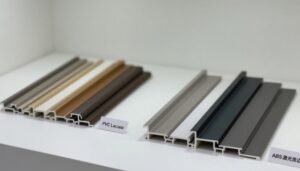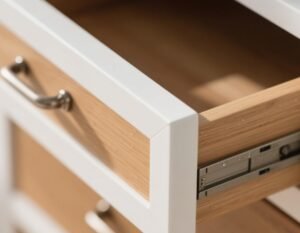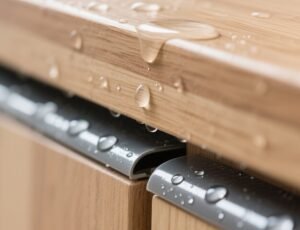Modern kitchen designs are all about clean lines and a seamless look. But one small mistake — like the wrong edge banding color — can ruin everything.
The right edge banding color helps kitchen cabinets look sleek and complete. Matching colors improve the overall design and create a high-end feel.

I’ve worked with many furniture manufacturers. The biggest design regret I hear is: “We should’ve picked a different edge band.” So if you want a modern kitchen that looks amazing and sells well, read on.
Why Edge Banding Color Matters in Modern Kitchen Design?
Designing a kitchen is hard enough. But many people forget that the edge banding color can make or break the look.
Edge banding color affects the finish and style of cabinets. Choosing the right one helps everything look smooth and intentional.

The Role of Edge Banding in Kitchen Style
- It hides raw board edges
- It adds contrast or blends in
- It protects cabinet panels from moisture and wear
Common Mistakes When Ignoring Color
| Mistake | Result |
|---|---|
| Mismatched edge banding | Looks cheap and inconsistent |
| Wrong sheen (gloss/matte) | Clashes with door finish |
| Overly bold color | Distracts from overall design |
In modern kitchens, we want simple, smooth, and stylish. A wrong color stands out in the worst way. That’s why edge color should be part of your core design decision — not an afterthought.
Popular Edge Banding Colors for Contemporary Kitchen Cabinets?
Many customers ask: “What are the most popular edge banding colors right now?” They want modern, but also timeless.
White, black, grey, wood grain, and metallic finishes are the top edge banding colors for modern kitchen cabinets today.

Top Colors and Their Best Use Cases
| Color | Works Best With | Comments |
| White | Glossy white doors | Clean and minimal look |
| Black | Matte or dark cabinets | Bold and sleek effect |
| Grey | Concrete-look panels | Neutral and trendy |
| Wood grain | Natural wood tones | Warm and classic |
| Metallic (silver/gold) | Handleless designs | Futuristic, high-end feel |
I once had a client using pure white cabinets and chose a slightly off-white band. The result? It looked “dirty.” Always color test under proper lighting before finalizing.
How to Match Edge Banding Colors with Cabinet Panels and Countertops?
People often ask me, “How do I know if the edge color will match?” The truth is — most don’t test it until it’s too late.
To match edge banding, you need to consider the panel material, surface finish, lighting conditions, and even your countertop color.

A Simple Matching Guide
1. Match or Contrast?
If you want seamless, choose the same color. If you want definition, go for contrast.
2. Consider Sheen and Texture
Glossy panels need glossy bands. Matte with matte. Wood texture? Use wood-patterned edge.
3. Lighting Matters
Always test samples under kitchen lighting. Daylight and LED can shift how colors appear.
| Panel Type | Suggested Edge Banding |
| High gloss white | High gloss white or silver |
| Matte black | Matte black or wood grain |
| Oak veneer | Matching oak wood grain |
| Stone laminate | Grey or metallic edge |
Matching is more than color. It’s feel, depth, and reflection. The more samples you test, the better result you’ll get.
Custom Edge Banding Options for Unique Kitchen Styles?
Not every customer wants “standard.” Designers often ask me for unique looks that still feel modern.
Yes, many manufacturers offer custom edge banding — including special colors, printed textures, and even custom logos.

Customization Options
- Pantone color matching
- Printed marble, textile, or leather patterns
- Dual-tone or layered color effects
- Edge banding with embedded metallic or translucent lines
I’ve worked with clients who needed navy blue high-gloss edge to match a yacht kitchen project. It wasn’t in stock. But our factory matched it perfectly within 10 days.
Custom options let designers break free from catalog limits. But they require longer lead times and higher MOQs.
Tips for Choosing the Right Edge Banding Color for Long-Term Use?
Some colors look good today but wear out fast. So I always get this question: “What edge color will still look good after 5 years?”
Choose colors that are neutral, easy to clean, and that won’t fade or stain easily under daily kitchen use.

Long-Term Factors to Consider
- UV resistance: White and grey are safest if UV-protected
- Stain hiding: Avoid solid bright colors in high-traffic areas
- Trends: Stay close to neutrals; extreme colors date faster
| Feature | Why It Matters |
| Easy to clean | Kitchen dirt, grease build up |
| Matches multiple door types | Reuse in future designs |
| Doesn’t yellow | Keeps clean look for years |
In my experience, light wood grains and satin grey edge bands age the best. They hide wear, stay stylish, and match most upgrades or remodels.
Conclusion
Choosing the right edge banding color is a small detail with a big impact. It decides if your kitchen looks cheap or classy — for years to come.




